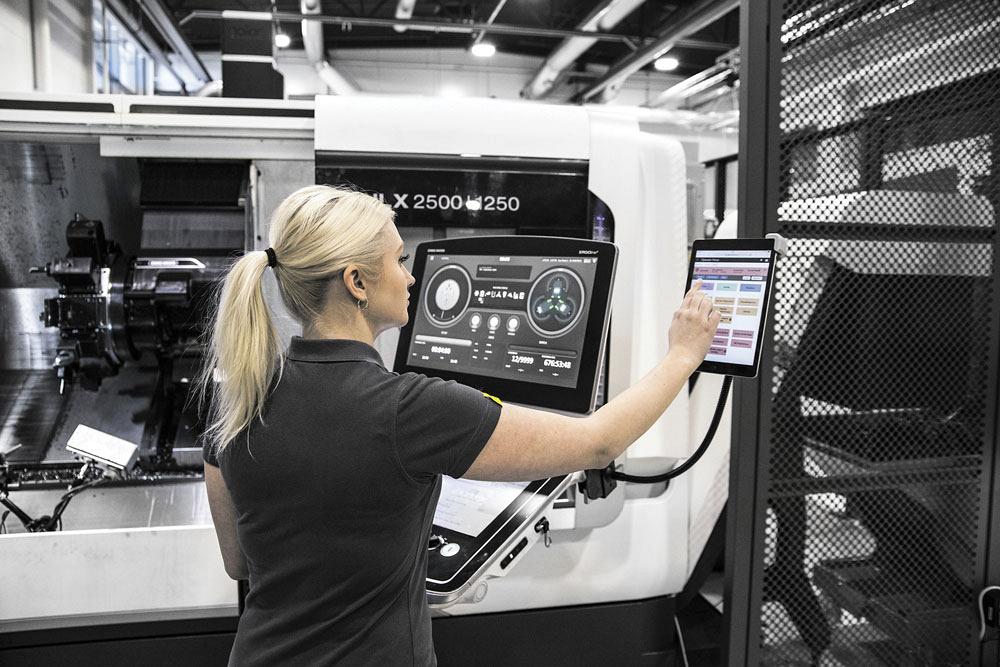Senior Digital Machining Specialist
- FMA
- The Fabricator
- FABTECH
- Canadian Metalworking
Technology Spotlight: Machine monitoring technology
Software platform helps manufacturers face the future through data management
- By Bijal Patel
- April 8, 2021
- Article
- Automation and Software
The Industrial Internet of Things (IIoT) is accelerating the pace of change around connecting machines, yet less than 30 per cent of manufacturers have extensively adopted Industry 4.0 technologies, according to a new report.
Digital machining experts recommend that manufacturers start listening to what their machines are saying by connecting them digitally with their machine shops.
The IIoT has perhaps impacted manufacturing more than any other industry. The IIoT market is set to grow to $98.2 billion by 2024 from $68.8 billion in 2019, yet a recent “Industry 4.0 & Smart Manufacturing Adoption” report from IoT Analytics, Hamburg, Germany, suggests that Industry 4.0 technology adoption is still low among manufacturers.
The transformation from linear plant setups to dynamic and interconnected systems is one of the greatest challenges for machine shops. Some are unsure of how Industry 4.0 fits into their established way of doing things. Many perceive that adding Industry 4.0 to existing production setups will be expensive, when it actually needn’t be. And other manufacturers see no reason to upgrade their existing tooling setup and processes.
Each business will be at a different stage of its journey toward embracing digitalization without any specific view as to how this should be achieved.
But they need to make up their minds, because COVID-19 continues to spell an unpredictable future for the industry. In its recent “COVID-19: Briefing” note, analyst McKinsey & Co. describes the upcoming climate for manufacturers as the next normal in which they can expect unpredictable and lasting shifts in customer markets.
The report states that resilience will be needed if manufacturers are to navigate an economically and socially viable path. Elsewhere, PwC’s own “COVID-19: What It Means for Industrial Manufacturing” report recommends that companies expand into new industries and take advantage of fresh revenue streams, either because they are forced to by defunct markets or because they simply spot an opportunity.
Manufacturers must get on board now with these concepts to adapt existing processes, and to do so quickly and cost-effectively — but how?
Data Gives Insight
One option is Sandvik Coromant’s CoroPlus MachiningInsights platform, an expansion of the company’s CoroPlus suite of connectivity software. The platform is designed to give manufacturers greater visibility of CNC machine tools and machining processes and provide the tools needed to analyze, identify, and eliminate common sources of downtime and inefficiency.
Such a platform should prove useful as both Industry 4.0 and the IIoT accelerate the pace of change around machine connectivity. It’s a system that helps manage the large volume of data. Any CNC with an Ethernet port can send information to the platform at higher volumes than most CNC shops currently collect for producing manufacturing data analytics to improve workshop efficiency and overall equipment effectiveness (OEE).

Sandvik Coromant’s CoroPlus MachiningInsights platform is designed to give manufacturers greater visibility of CNC machine tools and machining processes.
As for different manufacturers at different stages of their IIoT journey, machines that are less than 10 to 15 years old probably will already be connectible to the network, and there are adapters for older machines to make them network- capable.
MTConnect, the manufacturing technical standard for retrieving process information from numerically controlled machine tools, is the established protocol used to communicate with this software. It also can connect to other types of manufacturing equipment using standard communication protocols.
The Safety Question
One aspect of MTConnect that may raise eyebrows is that it only allows one-way communication. Some plant managers may regard the use of unidirectional, instead of bidirectional, communication as a drawback. Sandvik Coromant recognizes the argument, but the developers of MTConnect had some excellent reasons to make it unidirectional.
From my own experiences of working in machine shops for many years, I still question how we can remotely control equipment that has human beings around it, while also guaranteeing their safety. Unidirectional communication puts control firmly in the user’s hand for a simpler and safer approach.
Another question of safety is that two-way communications make a machine tool more difficult to manage from a cybersecurity point of view. Many of today’s CNCs run Microsoft Windows, which historically has been known to present vulnerabilities. By limiting the flow of data to unidirectional communication, we help close that door and make certain that a shop’s million-dollar multitasking machine will not be held for ransom.
Better Access
Before implementing MachiningInsights, a shop supervisor might spend each morning entering performance indicators from the previous day’s production into a spreadsheet, then distribute that information to management and on to people on the production floor.
If an operator adjusts a feed rate override, a tool breaks, or the machine has been idle for a given number of minutes, the software provides users with the ability to configure email or SMS alerts based on any one of several dozen conditions or events, which are just a few of the everyday situations that contribute to machine downtime.
The platform comes with a set of preconfigured reports and dashboards to get users up and running quickly, and they are free to modify them or to build their own from scratch. Users can log on to their MachiningInsights website and view whatever they have been allowed access to by the shop’s administrator.
Anyone who wants to see this data can open real-time dashboards and reports, gaining visibility of what is currently happening, rather than what happened yesterday. The supervisor now has more time to act on information instead of simply collecting it for historical purposes.
If manufacturers already have an enterprise resource planning (ERP) system in place and want to avoid installing another software package, a standard application programming interface (API) can be used by tech-savvy shops to connect the platform with other software.
As with all software as a service (SaaS) products, there is a subscription fee based on the platform level and the number of machines to monitor, but ROI typically is attained in weeks or months, not years.
New Ways to Automate
ThePwC report also states that manufacturers should expect a learning curve as companies devise new ways of working that involve more remote employees and automation on the factory floors.
For workshops that are running unattended or lightly attended, the platform can monitor spindle and servo loads, macrovariables, operational status, and, if the machine is equipped with the right sensors, temperature and power.
The IIoT will continue its rapid growth and make countless productivity, profit, and maintenance advantages available to machine shops that are willing to overcome their reluctance to embrace Industry 4.0. With the use of advanced software, manufacturers can go digital on their own terms.
The Big 3
Sandvik Coromant’s Bijal Patel answers the three most common questions manufacturers have about making the move to digital manufacturing and IIoT implementation.
Q: Our shop is already collecting data on machine utilization in other ways. Why move to CoroPlus MachiningInsights?
A: I’ll give you a small example from a customer I worked with recently. Before implementing MachiningInsights, the shop supervisor spent each morning entering various performance indicators from the previous day’s production into a spreadsheet, then distributed that information to management and the people on the production floor. Now anyone who wants to see this data can open various real-time dashboards and reports and gain visibility of what’s happening right now, as opposed to what happened yesterday.
The supervisor now has more time to act on this information instead of simply collecting it for historical purposes.
Q: Because of COVID-19, I don’t want visitors in my facility right now. Can I install it myself?
A: MachiningInsights is a subscription-based software as a service, or SaaS, so it must be installed by Sandvik Coromant. However, this can all be accomplished remotely.
Once you have identified the machines you want to monitor, you pay a one-time installation fee, give us access to your server via TeamViewer or similar remote desktop software, and we take it from there. The software comes with a set of preconfigured reports and dashboards, so it's easy to get up and running quickly, but you are free to modify these or build your own from scratch.
Once everything is ready, users can just log on to their MachiningInsights website and view whatever they've been given access to by the shop’s administrator. As with all SaaS products, there is a subscription fee based on the platform level and the number of machines you want to monitor.
Q: What if I want to collect other information, such as reason codes or operator input?
A: Absolutely. There's an operator panel feature available, and they can use an external device such as a tablet, PC, laptop, or even a smartphone. Either way, they can either type in the desired information or tap a preconfigured button to indicate, for example, why the machine has stopped or that a drill was just changed.
Operators can also do things like notify the tool crib that they’re about to run out of inserts or enter a ticket with the engineering department that there's a problem. All of these activities can be recorded for analysis or further escalated if necessary.
Supervisors also can use that same interface to present operator instructions based on these events. For example, if the spindle load exceeds a specific value during a roughing operation, a set of work instructions for changing that tool can pop up.
Bijal Patel is senior digital machining specialist for Sandvik Coromant, 2550 Meadowvale Blvd., Unit 3, Mississauga, Ont. L5N 8C2, 905-826-8900, www.sandvik.coromant.com.
About the Author
Related Companies
subscribe now


Keep up to date with the latest news, events, and technology for all things metal from our pair of monthly magazines written specifically for Canadian manufacturers!
Start Your Free Subscription- Trending Articles
Sustainability Analyzer Tool helps users measure and reduce carbon footprint

Enhance surface finish with high-speed machining

Equispheres secures $20 million investment round

Solid carbide drills produce precision holes in short chipping materials

Okuma announces new personnel appointments

- Industry Events
Automate 2024
- May 6 - 9, 2024
- Chicago, IL
ANCA Open House
- May 7 - 8, 2024
- Wixom, MI
17th annual Joint Open House
- May 8 - 9, 2024
- Oakville and Mississauga, ON Canada
MME Saskatoon
- May 28, 2024
- Saskatoon, SK Canada
CME's Health & Safety Symposium for Manufacturers
- May 29, 2024
- Mississauga, ON Canada
















